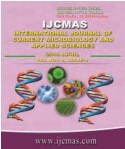


 National Academy of Agricultural Sciences (NAAS)
National Academy of Agricultural Sciences (NAAS)

|
PRINT ISSN : 2319-7692
Online ISSN : 2319-7706 Issues : 12 per year Publisher : Excellent Publishers Email : editorijcmas@gmail.com / submit@ijcmas.com Editor-in-chief: Dr.M.Prakash Index Copernicus ICV 2018: 95.39 NAAS RATING 2020: 5.38 |
Blackgram is a major kharif pulse crop in Kota district of Rajasthan, which covers more than 25 percent acreage of kharif sown area of the district. However, average yield of the district varying between 5-7.25 q ha-1 which can be enhanced up to 10 q ha-1 or more by the adoption of new varieties and recommended agro-techniques. To demonstrate improved production technologies, cluster front-line demonstrations were conducted on blackgram crop by Krishi Vigyan Kendra, Kota, during kharif 2016 to 2018 on 260 farmer fields of the district. Technological interventions demonstrated consists of use of variety Pant urd-31, seed treatment with carbendazim50 WP @ 2.0 g /kg seed & inoculation of Rhizobium & PSB culture, sowing in 30 cm rows apart, recommended doses of NP (20-40 kg ha-1) and zinc sulphate (25 kg ha-1), weed management by application of imazathapyr 10 SL @ 550 ml/ha 15-20 DAS and sucking pest management by application of imidacloprid 17.8 SL @ 250 ml/ha. The study of three years data revealed that demonstrated technologies resulted in substantially higher yield of blackgram than that of local check with mean seed yield of 8.37 q ha-1 which represents 39.27 cent yield enhancement over local check (6.01 q ha-1). Demonstrated techniques fetched average net returns of Rs 21345 ha-1 with B: C ratio of 2.09, higher in comparison to local practice (Rs 13627 ha-1 with B: C ratio 1.86). An average additional returns of Rs.11484 ha-1 was obtained under demonstrated technologies with incremental B: C ratio of 3.05. Yield gap analysis showed average extension gap of 2.36 q ha-1, emphasizes the need for transferring the feasible improved technologies among farmers to bridge the existing extension gap. Technology index in the present study varied between 31.00 to 61.73 per cent and averaged 44.20 per cent.
 |
 |
 |
 |
 |